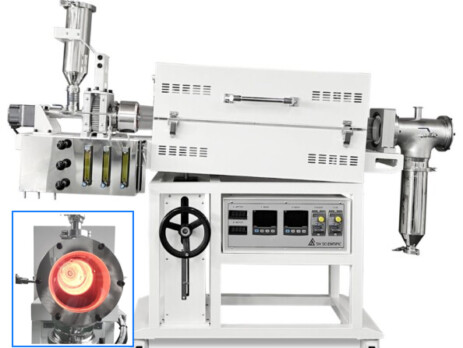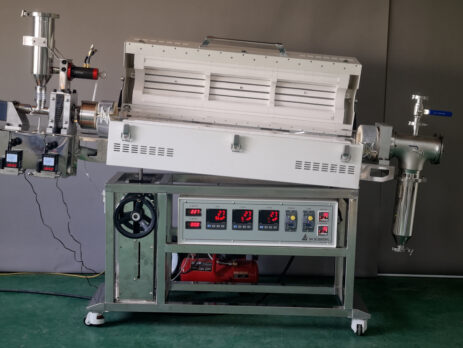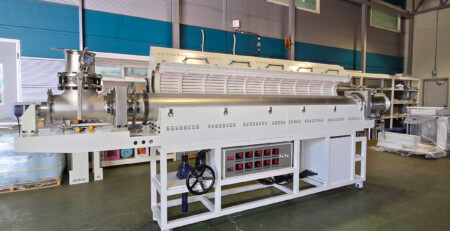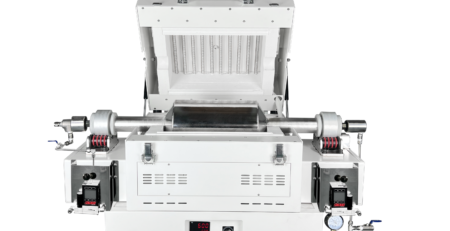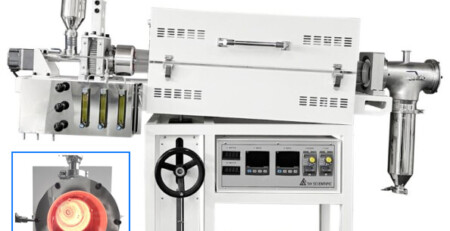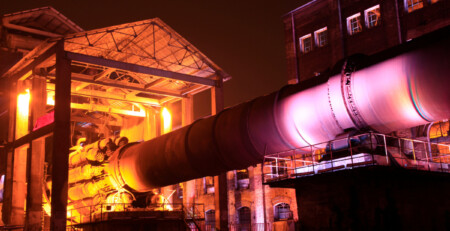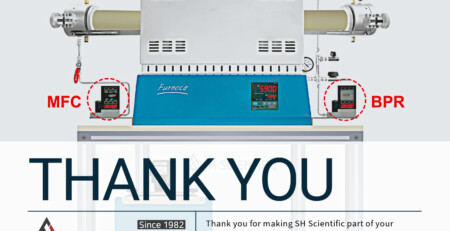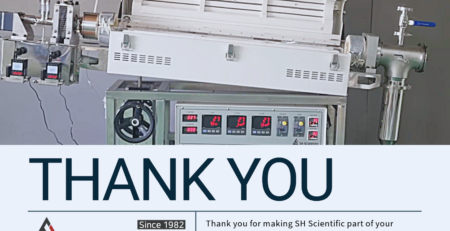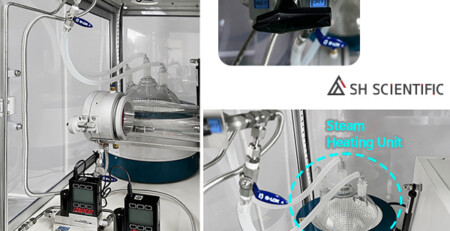Rotary Tube Furnace (Lab Scale Kiln) in Chemical Vapor Deposition (CVD)
Rotary tube furnaces, also known as lab-scale kilns, play an essential role in Chemical Vapor Deposition (CVD) processes that require uniform coatings, efficient mixing, or continuous processing. SH Scientific offers advanced rotary tube furnaces designed for a variety of applications, including food waste processing, biochar production, and biomass processing.
Rotary Tube Furnace Overview
The SH Scientific rotary tube furnace is a specialized laboratory instrument used for the thermal treatment of materials under controlled atmospheres. It features a cylindrical reaction chamber that can rotate continuously or at set intervals, enhancing the uniformity of material deposition and promoting even coating formation. This rotation facilitates the even distribution of gaseous precursors and substrate particles, making the furnace highly versatile for lab-scale CVD applications, particularly in fields such as biomass processing, high-purity material synthesis, and advanced energy storage.
Applications of SH Scientific Rotary Tube Furnaces in CVD
- Food Waste and Biochar Processing: Rotary tube furnaces are used for the pyrolysis of food waste to produce biochar. The rotary motion ensures that organic materials are uniformly exposed to heat, promoting efficient carbonization. The integration of optional heating jackets prevents tar condensation, maintaining a cleaner process environment.
- Catalyst Preparation: In catalyst production, the rotary tube furnace is employed to coat catalyst particles with active materials via the CVD process. The rotating mechanism ensures that precursor gases uniformly cover each particle, resulting in consistent catalytic activity. This level of uniform coating is critical in automotive exhaust catalysts and chemical reactors, where precise performance is necessary.
- Battery Material Processing: Rotary tube furnaces are widely used in synthesizing high-purity materials for battery production, including anode and cathode materials. The SH Scientific rotary tube furnace provides a controlled environment for continuous pyrolysis and CVD, which are essential for achieving consistent quality in battery materials. The programmable rotation and adjustable incline angle allow fine control of residence time, optimizing electrochemical properties.
- Hydrogen Fuel Battery Production: The rotary tube furnace is also suited for hydrogen fuel battery production. The ability to perform oxidation and reduction under controlled atmospheres makes it a key tool for fabricating advanced materials used in hydrogen energy systems.
- Nanomaterial Synthesis: Rotary tube furnaces are particularly advantageous for synthesizing nanomaterials, such as carbon nanotubes and graphene. The rotating reaction chamber prevents agglomeration of particles, ensuring more uniform reactions and high-quality deposition. This is crucial for producing nanomaterials that exhibit desirable electrical conductivity, mechanical strength, and other properties for applications in electronics, aerospace, and energy.
Features of SH Scientific Rotary Tube Furnaces
- Precise Temperature Control and Uniform Heating: The SH Scientific rotary tube furnace features stainless steel or quartz tubes with a maximum operating temperature of 1200°C. Advanced digital controllers ensure consistent temperature across the entire hot zone, which is critical for high-quality deposition in CVD applications.
- Programmable Controller: The rotary tube furnace is equipped with a programmable controller that supports two patterns and 15 segments per pattern, allowing for a total of 30 segments. This enables researchers to create precise heating profiles, contributing to better control over the CVD process.
- Optional Features for Enhanced Processing: The SH Scientific rotary tube furnace includes optional features such as a hammer vibrator for processing high-viscosity organic materials, such as food waste, and heating jackets to prevent tar condensation. These features are designed to maintain efficient material flow and ensure a clean process environment.
- Efficient Gas Handling: The furnace includes a 1/4″ inert gas in/out port and a KF25 outgassing port, which supports an optimal gas exchange environment for the CVD process. This ensures that gaseous precursors are properly managed, resulting in high-quality, uniform deposition.
- Monitoring and Control: The integrated quartz window provides a viewport for real-time monitoring of the material during the CVD process. Combined with the precise programmable control of gas flow and tube rotation, this feature allows researchers to optimize film uniformity and material properties.
- Anti-Clogging and Continuous Processing: The rotary tube furnace is particularly suited for continuous processing. The feeding and receiving system is designed to allow materials to flow smoothly from the feeding tank at the upper end to the receiving vessel at the lower end. Anti-clogging features, such as the hammer/vibration mechanism, ensure a steady flow of viscous materials, facilitating uninterrupted processing.
Advantages of SH Scientific Rotary Tube Furnaces for CVD
- Enhanced Uniformity: The continuous rotation of the tube ensures even distribution of gaseous precursors, leading to uniform coatings on substrates. This is especially vital when processing powder materials or multiple small substrates, where inconsistencies can lead to defects.
- Versatility for Different Atmospheres: The rotary tube furnace is suitable for both oxidation and reduction processes, providing a controlled environment for a variety of atmospheres. This versatility is particularly useful for developing new materials or modifying existing materials to achieve desired properties.
- Scalable for Laboratory Use: Designed for lab-scale applications, SH Scientific’s rotary tube furnaces allow controlled experimentation with smaller quantities of materials while offering features that are scalable to industrial production. This enables researchers to optimize experimental parameters before scaling up to larger production volumes.
- Durability and Efficiency: The use of Kanthal-A heating elements, double housing for low surface temperature, and ceramic insulation contribute to the furnace’s durability and energy efficiency. The lightweight design ensures prompt heat-up, making it a convenient option for laboratory settings.
SH Scientific’s rotary tube furnaces are engineered to provide optimal performance in lab-scale CVD applications, offering uniformity, efficient gas flow, and precise temperature control. These furnaces are integral to advancing the capabilities of the CVD process in applications such as food waste pyrolysis, advanced energy storage materials, and hydrogen fuel production. For more information or customized solutions, contact SH Scientific.

